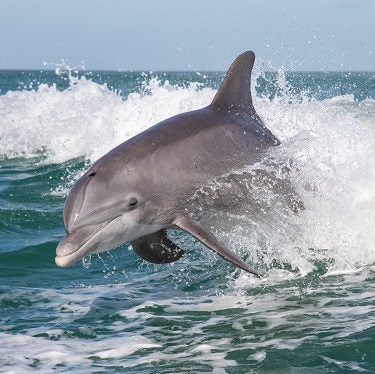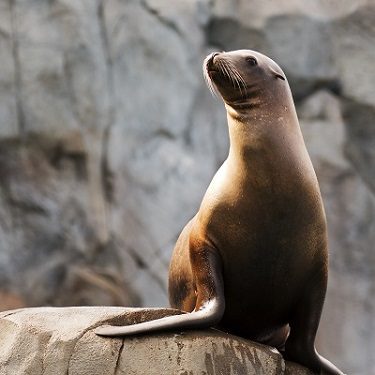Marine Life Encyclopedia
Marine Mammals
Dugong
Dugong Dugon
Distribution
Tropical to sub-tropical latitudes of the Indian and western Pacific oceans
eCOSYSTEM/HABITAT
Seagrass beds
FEEDING HABITS
Herbivore
TAXONOMY
Order Sirenia (manatees and relatives), Family Dugongidae (dugongs)
The dugong, like all sea cows, is herbivorous. It primarily grazes on sea grasses and therefore spends most of its time in sea grass beds. Unlike the closely related manatees, the dugong never enters freshwater and is therefore the only exclusively marine mammal that is herbivorous. As in most herbivores, the dugong’s brain is very small compared to its body size, likely because it does not have to develop complex hunting strategies to capture prey.
Dugongs reproduce via internal fertilization and give birth to large young, which they nurse for as long as a year and a half. Adult dugongs do not have any natural predators, but juveniles may be eaten by saltwater crocodiles, killer whales, and large, coastal sharks.
The dugong has some or complete legal protection throughout most of its range, but it is still hunted in some places and is threatened by habitat destruction, collision with boats, and accidental capture in fisheries targeting other species throughout most of its range. Populations are depleted in some places and regionally extinct in others, and scientists believe the dugong to be vulnerable to extinction. Without careful management of the human activities that threaten the dugong, it could be lost from more places.
Note on a closely related species: In addition to the dugong and the manatees, another species of sea cow used to be common in the north Pacific Ocean. The Steller’s sea cow (Hydrodamalis gigas) was the only other species in the Dugongidae family in modern times, but it was hunted to extinction by hunters and explorers in the 1700s. Formerly one of the largest marine mammals after the great whales, the Steller’s sea cow will never live again. That species provides an example of what is possible if hunting or fishing happens to an unsustainable degree.
Fun Facts About Dugongs
1. Dugongs grow to a maximum length of 13 feet (4 m) long and weight of 595 pounds (270 kg).
2. Dugongs can live up to 70 years.
3. Dugongs are referred to as sea cows because they use their strong, cleft upper lips to graze on sea grasses they uproot from the seafloor.
4. Dugongs are sirenians and therefore related to manatees. Though they resemble cetaceans (whales, dolphins and porpoises), dugongs and manatees are believed to be descendants of land mammals that make them more closely related to elephants than whales.
5. Dugongs live only in coastal waters of the Pacific and Indian Oceans from east Africa to the Red Sea and Australia.1
Engage Youth with Sailors for the Sea
Oceana joined forces with Sailors for the Sea, an ocean conservation organization dedicated to educating and engaging the world’s boating community. Sailors for the Sea developed the KELP (Kids Environmental Lesson Plans) program to create the next generation of ocean stewards. Click here or below to download hands-on marine science activities for kids.
Additional Resources:
1 The MarineBio Conservation Society
Get Involved

Donate Today
SUPPORT OUR WORK TO PROTECT THE OCEANS BY GIVING TODAY
With the support of more than 1 million activists like you, we have already protected nearly 4 million square miles of ocean.

TAKE ACTION NOW
Support policy change for the oceans
Decision-makers need to hear from ocean lovers like you. Make your voice heard!

VISIT OUR ADOPTION CENTER
SYMBOLICALLY ADOPT AN ANIMAL TODAY
Visit our online store to see all the ocean animals you can symbolically adopt, either for yourself or as a gift for someone else.

DOWNLOAD OCEAN ACTIVITIES
HELP KIDS DISCOVER OUR BLUE PLANET
Our free KELP (Kids Environmental Lesson Plans) empower children to learn about and protect our oceans!




